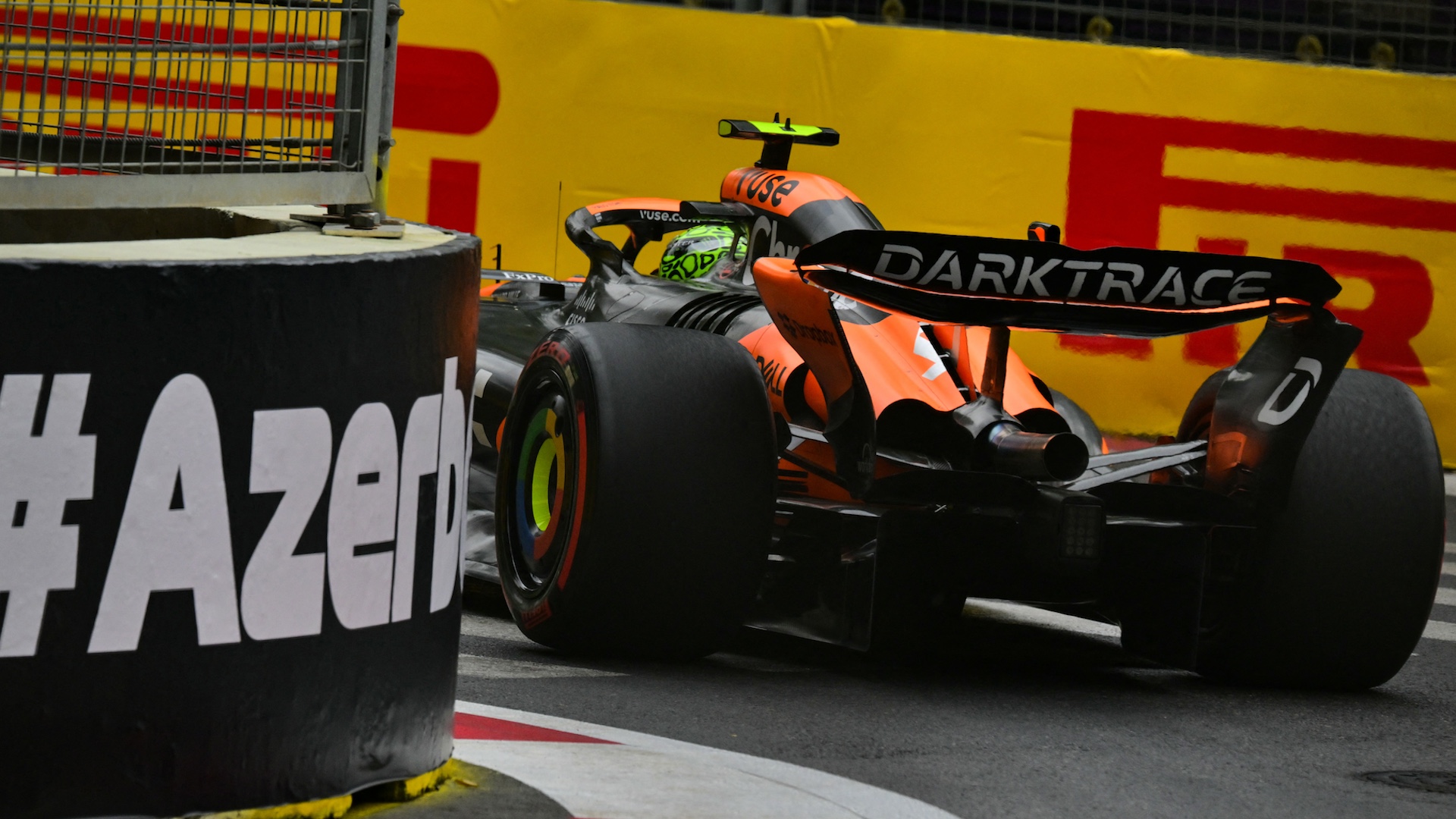

Oscar Piastri’s dominant win at the 2024 Azerbaijan Formula 1 Grand Prix can be credited to a variety of factors: McLaren’s comprehensive in-season upgrade packages, Piastri’s cool-headed skill, a helping hand from teammate Lando Norris, and the driver’s executive decision to ignore his race engineer’s request that he avoid overtaking Charles Leclerc. Oh—and a little rear-wing trick that ever so carefully skirts the limits of legality.
Some folks are calling it a flexi-wing. Some are calling it mini-DRS. But when you look at rear-facing onboard footage from Piastri’s car, you can see something interesting: The outer portion of McLaren’s rear wing DRS flap lifts ever so slightly as Piastri negotiates the serpentine streets of Baku.
First, let’s talk about how this wing works. When McLaren’s MCL38 is stationary, its rear wing looks completely normal—which is critical, because F1 cars are stationary when scrutineering takes place.

When you send the car out on track at speed, though, you’ll notice the wing changes. Specifically, there’s a gap between the main plane’s trailing edge and the leading edge of the flap. The wing can deform ever so slightly and pop open a little gap in the wing.
It’s not much; the gap doesn’t seem to be anywhere near wide enough for even an adult finger to slip through. But it’s more than enough.
That teeny gap functions like a miniature version of DRS. When drivers activate their drag reduction system, the wing flap opens up entirely, which reduces drag and gives drivers a little ‘boost’ in speed by eliminating one place where buffeting air slows a car down.
The gap that McLaren engineered in its rear wing opens up just enough to reduce some of the air pressure—giving the car a minor DRS-esque boost in speed.
To claim that this wing gap is the only thing—or even the main thing—that contributed to Oscar Piastri’s Baku win would be silly. The Woking-based team has introduced a slew of upgrades to its car all year long, all of which have helped it make tangible steps forward in terms of speed, balance, and comfort. The upgrades have also coincided with the growth of two fantastic drivers in Piastri and Norris. There are hundreds of little details that go into making a car capable of winning a race—and the flexible mini-DRS wing is only one of them.
The biggest thing everyone wants to know, though, is whether or not that flexi-wing is actually, y’know, legal.
Right now, the answer is a tentative “yes.” Blake Hinsey, a former Formula 1 performance engineer for Red Bull, stated that, “If the technical regulations have specifications for rear wing deflection and this passes the tests, then it’s legal. Every piece of bodywork moves in complex ways under aerodynamic load. If McLaren has found a way to reduce the drag on their rear wing differently, congratulations. They’ve done a brilliant job engineering this system.”

F1 is a sport of nuance, and the best F1 engineers and designers are the ones who can exploit all of the complex loopholes and gray areas within any set of technical regulations. That’s how we ended up with monocoque chassis, rearward engine placements, and wings in the first place. If the rules don’t forbid it, then it’s fair game.
For now, at least.
Just because something isn’t in the rules doesn’t mean it can’t be added, and both F1 and the FIA are known for instituting mid-season technical directives to quash unintended innovations in the rules.
Heading into the Singapore round in 2023, for example, the FIA issued a technical directive that clamped down on excess flexibility in front and rear wings.
FIA Single Seater Technical Director Tim Goss explained at the time, “For us, the important bit of Article 3.2.2 is that ‘all aerodynamic components or bodywork, influencing the car’s aerodynamic performance must be rigidly secured and immobile with respect to their frame of reference and that they must make use a uniform, solid, hard, continuous surface under all circumstances.’
“Now, quite clearly things cannot be totally rigid. So, we have a range of load deflection tests that define how much elements can bend, and we’ve evolved those tests to represent what the teams are trying to achieve on track and to put a sensible limit on them.
“We play by those rules, while teams look to exploit the allowance in terms of deflection. That’s normal. So the TD is just about making sure that we, the FIA, and the teams, all have a common understanding of where we will draw the line in terms of these design details.”

Basically: The FIA determined that teams weren’t doing anything explicitly illegal. They were just making use of a loophole that the technical directions failed to properly close.
Right now, McLaren’s mini-DRS wing likely falls within that gray area—making it an innovation that isn’t expressly allowed, but not expressly illegal, either. The FIA won’t punish McLaren for being creative, but it’s very likely we’ll see a technical directive in the near future designed to clamp down on moveable wings like McLaren’s. At that point, it’ll only be illegal if McLaren continues to use its flexi-wing after a technical directive forbids it.
Whether you like the McLaren innovation or not, you have to give the team’s design crew credit for preserving the technical excitement of the sport.
Got a tip? Email us at tips@thedrive.com